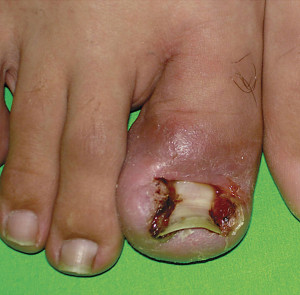 Pain on the sides of your toe, swelling and a feeling of sensitivity are often signs of an ingrown toenail, in which the toenail and surrounding tissue grows irregularly. There is no real treatment option, although medical attention may be needed for a severe case.
Pain on the sides of your toe, swelling and a feeling of sensitivity are often signs of an ingrown toenail, in which the toenail and surrounding tissue grows irregularly. There is no real treatment option, although medical attention may be needed for a severe case.
Causes of Ingrown Toenails
There can be several causes, including not cutting the toenails properly toenail fungus, wearing stockings or socks which are too tight or wearing shoes that are tight and uncomfortable. The toenails can grow abnormally, if not cut properly or cut too short.
Preventing Ingrown Toenails
Wearing suitably sized shoes can help prevent the problem, also known as onychocryptosis, as can cutting the toenails correctly, especially the big toe. You will need to have a podiatrist cut the corners of your nails short, to prevent them from digging into the flesh. If toenail fungus is the main cause of ingrown toenails, you can treat it using lasers. Laser treatment for toenail fungus is one of the most effective ways of getting rid of fungal infections permanently.
Reducing the Pain
The pain can be treated temporarily by following the advice above; any serious pain will need to be dealt with by a podiatrist, to ensure proper circulation of blood and to make sure there is no infection.If you are using clippers to treat your toenails, they should first be sterilized. The clippers can then be used to gently cut away the ingrown toenail, making sure not to damage the skin. After using the clippers, you should soak your toe in betadine solution for 20 minutes, and then apply antibiotic cream and a bandage.
Professional Help
However, in serious cases, a professional will have to treat and remove your ingrown toenail, and this typically involves draining any fluid from the affected area. For permanent relief from the pain and discomfort, your podiatrist may use a chemical process to destroy the nail root. In extreme cases, you may need to have some or all of your toenail removed, a technique that requires a local anaesthetic or sedation. Additional relief can be had with oral medication.
Stages Associated With Ingrown Toenails
There are three stages associated with ingrown toenails: stage one consists of swelling and redness, while an infection and pain are typical of stage two. During the third stage, the nail hypertrophies and granulated tissue appears.
Home remedies, such as soaking the toes in antiseptic, can be effective, as can elevating the nail corner with a cotton wick. However, if the ingrown toenail develops to the second or third stage, more drastic treatment may be needed, such as removal of the nail and tissue. Always follow your doctor’s advice or that of your podiatrist.


